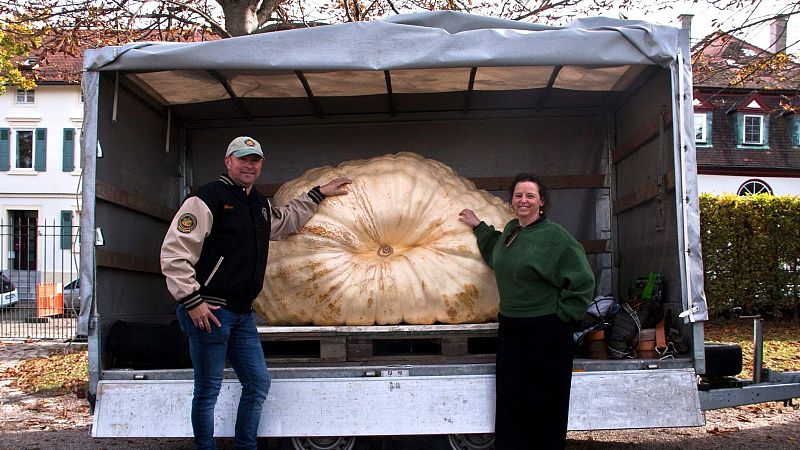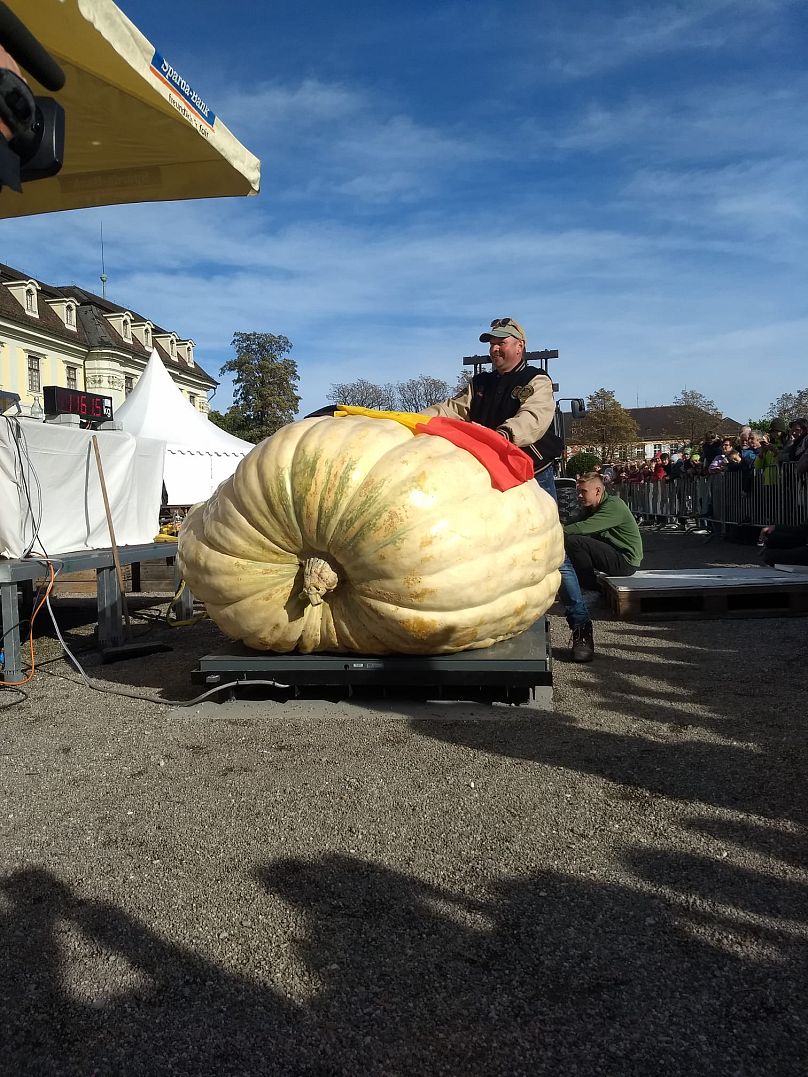Behind the scenes of giant pumpkin growing with the 2024 European champion

Last Sunday, an entourage of giant pumpkins and their growers rolled into the town of Ludwigsburg, Germany.
Part of the world’s largest pumpkin festival, they were there for the annual weigh-in to reveal who had grown Europe’s heaviest pumpkin in 2024.
Belgium’s Mario Vangeel was crowned champion on 13 October, with a colossal pumpkin weighing in at 1,152kg - around the same as a small car.
No newcomer to the art of growing giant pumpkins, Mario was the 2019 Belgian national champion. He also made headlines in 2021, with a pumpkin that came second to that year’s world record-breaking effort by Italian Stefano Cutrupi.
Yet Mario was still surprised to take the title this year. “I was hoping yes, but I didn’t think I was going to win,” he tells Euronews Green.
The 50-year-old, whose day job is driving tractors for a contracting company, puts his success down to a lucky combination of conditions: “I had a good seed, the plant grew well, it was warm enough and I gave it a good fertiliser.”
If you’re curious as to what goes into the fertiliser that nourished Mario’s winning pumpkin, you won’t find the answer here – or anywhere else.
“That’s a little secret,” he says mysteriously. “Each grower has their own mix, a little thing they do differently.”
The town of the pumpkin eaters
It might sound like a niche hobby, but in Mario’s hometown of Kasterlee there’s a thriving club of giant pumpkin growers, with around 50 members.
This ‘glut’ of local growers is no coincidence. The gourd is part of Kasterlee’s heritage, so much so that the people here are nicknamed the ‘Pumpkin Eaters’.
“They found papers from the 1600s saying that because they had poor land, they couldn't grow a lot of food. But pumpkins did very well here,” explains Mario’s wife Bieke, who’s also become part of the giant pumpkin growing world given her husband’s dedication to the practice. “And that’s where it started.”
“Obviously they were only small back then. Nowadays the giant ones need good soil to grow.”
While Mario’s pumpkin flourished this year, others in Kasterlee were not so lucky, thanks to some pumpkin eaters of an unwelcome variety. “Several growers had to deal with snails,” says Mario. “There were a lot more this year, we think because of the wet weather – we’ve had a lot of rain.”
“Another grower had a very big pumpkin, also more than 1,000kg. One week before the weigh off, a snail made a little hole in it and it was finished. After a couple of days it was rotting, and they couldn't weigh it anymore.”
“It’s something growers will have to think about for next year – how to keep the snails out of the greenhouse.”
Putting pumpkins to use
For the pumpkins that do make it all the way to competition, what happens next?
These giant varieties aren’t bred for taste, with the high water content reducing the flavour. So instead of being eaten, the biggest are often showcased at exhibitions and fairs. And in Kasterlee, some are put to a more creative use altogether.
“The club is going to use the ones that aren’t so big, around 300 or 400kg, for sailing,” says Bieke. “They’re going to row in them.”
She’s referring to the town’s annual Pumpkin Regatta, which started in 2008 as a collaboration between Kasterlee’s pumpkin and kayaking clubs. It now attracts hundreds of participants, who take to the water in hollowed-out pumpkins, and around 5,000 spectators.
This year’s race takes place on 27 October and there’s even international competitors – teams from Spain and England will be racing.
Sailboats might be a fitting use for these giant pumpkins, but most of us this autumn are more likely to encounter varieties marketed for Halloween carving.
While a fun tradition, carving creates an enormous amount of food waste. Polling by UK environmental charity Hubbub in 2023 found that 15.8 million pumpkins would go uneaten.
Unlike the giant varieties, regular pumpkins are perfect for cooking. Hubbub recommends decorating the exterior of your pumpkin instead of carving it, so you can eat the flesh once the festivities are over.
Living up to their reputation as ‘Pumpkin Eaters’, the Vangeels have a few recipe suggestions, for anyone keen to make the most of the veg in the kitchen.
For Mario, it’s all about a classic. “We eat a lot of pumpkin soup,” he laughs. “It’s very simple, made with just onions and curry powder really.”
Bieke also recommends spaghetti pumpkin, where you roast the vegetable until it’s soft and then use a fork to create spaghetti-style strands from the flesh.
World record ambitions
When the question of whether Mario will enter the European championship again next year comes up, it’s a resounding yes. And he’s got his sights set beyond Europe. “I want to be world champion once – it’s a dream to break the record,” he reveals.
This year’s pumpkin almost matched the Belgian national record of compatriot Mathias Willemijns, which stands at 1,190kg. The current world record he’s striving to outgrow is 1,296kg, held by American Travis Gienger since 2023.
“This started as a hobby but it’s become a bit of a sport. I want to keep growing bigger pumpkins every year,” the Belgian challenger says.
Mario might already be looking ahead to future seasons, but Bieke is just pleased this one is over.
“He’s almost out there sleeping with that pumpkin,” she jokes. “It gets a lot of love and kisses, and now I'm glad the kisses are back for me.”


